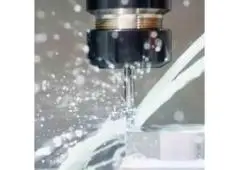Description
In the intricate dance of metalworking, where precision meets power, one crucial partner often overlooked is the lubricity improver. Behind the scenes, these unsung heroes play a pivotal role in enhancing the performance of metalworking fluids, ensuring smoother operations and superior results across various industrial processes. From cutting and grinding to forming and shaping, the effectiveness of metalworking fluids heavily relies on their lubricating properties, and lubricity improvers are the secret sauce that optimizes this performance.
Understanding the Basics
Metalworking fluids (MWFs) are substances used to cool and lubricate metal workpieces and cutting tools during machining operations. They prevent friction, dissipate heat, flush away chips, and protect surfaces from corrosion. Traditional MWFs include oils, emulsions, and synthetic fluids, each tailored to specific applications and machining processes.
Lubricity, a critical aspect of MWF performance, refers to the fluid's ability to reduce friction between the cutting tool and the workpiece, thereby minimizing wear, heat generation, and tool breakage. While conventional MWFs possess inherent lubricating properties, challenges arise when dealing with demanding applications, exotic materials, or high-speed machining, necessitating the use of lubricity improvers.
The Role of Lubricity Improvers
Lubricity improvers are chemical additives meticulously formulated to augment the lubricating characteristics of MWFs. They function by forming a protective boundary layer between the cutting tool and the workpiece, reducing metal-to-metal contact and mitigating frictional forces. By enhancing lubricity, these additives facilitate smoother machining operations, extend tool life, improve surface finish, and elevate productivity.
Key Benefits and Applications
Reduced Wear and Tool Breakage: Lubricity improvers minimize frictional wear on cutting tools, thereby extending their lifespan and reducing the frequency of tool changes. This not only lowers maintenance costs but also enhances machining consistency and dimensional accuracy.
Enhanced Surface Finish: Improved lubrication leads to reduced surface roughness and finer finishes on machined components. This is particularly crucial in precision engineering applications where surface quality directly impacts product performance and aesthetics.
Increased Machining Speeds and Feeds: Lubricity improvers enable higher cutting speeds and feed rates by reducing the risk of heat buildup and tool overheating. This boosts machining efficiency and throughput without compromising tool integrity or workpiece quality.
Compatibility with Various Materials: From conventional metals like steel and aluminum to exotic alloys and composites, lubricity improvers exhibit versatility across a wide range of materials and machining processes, making them indispensable in diverse industrial settings.
Innovations and Future Trends
Advancements in lubricity improver technology continue to push the boundaries of metalworking fluid performance. Researchers are exploring novel additives, such as nano-scale lubricants and boundary film-forming compounds, to achieve unprecedented levels of lubrication and friction reduction. Additionally, there's a growing emphasis on environmentally friendly formulations that minimize health and environmental risks while maintaining superior performance.
Furthermore, with the advent of Industry 4.0 and smart manufacturing, lubricity improvers are increasingly integrated into holistic machining solutions that leverage data analytics, machine learning, and IoT sensors to optimize lubrication regimes in real-time, maximizing efficiency and resource utilization.
Keywords: Lubricity Improver, Rust Inhibitor, Extreme Pressure Additives, Semi Synthetic Cutting Oil Additives, Anti Wear Additives, Metal Working Additives, Cutting Oil Additives, Eco Friendly Cutting Oil, Bounday Layer Lubricants, Additives for Synthetic MWF, Corrosion Inhibitor, Eco Friendly Metal Working Fluid, Just Add & Sell, Lubricity additive, Lubricity enhancer, Lubricity improver for metalworking fluids, Cutting oil lubricity improver, Lubricity Improver for coolant, Lubricity Improver, Lubricity Enhancer, Lubricity Additives, Lubricity Agent, Lubricity Improver for cutting oil, Lubricity Improver for metal working fluid, Lubricity Agent for cutting oil, Lubricity Agent for metal working fluid, Lubricity Agent for soluble oil, Lubricity agent for water based cutting oil, Cutting oil additive rust inhibitor, Rust inhibitor additive for metalworking fluids, Rust inhibitor additive for cutting oils, Rust inhibitor additive for water-soluble cutting oils, Water-soluble cutting oil additive rust inhibitor, Metalworking fluid extreme pressure additive, Cutting oil extreme pressure additive, EP additive for metalworking fluids, EP additive for cutting oils, Extreme pressure additive for metalworking fluids, Extreme pressure additive for cutting oils, Water-soluble cutting oil extreme pressure additive, EP additive for water-soluble cutting oils, Extreme pressure additive for water-soluble cutting oils, Anti-wear additives for metal working fluids, Anti-wear additives for water-based cutting oils, Anti-wear additives for soluble cutting oils, Anti-wear additives for water soluble cutting oils, Anti-wear additive for soluble cutting oil, Anti Wear Additive, Anti Wear Additive for metalworking fluids, Anti Wear Additive for cutting oils, Anti Wear Additive for coolant, Anti Wear Improver, Anti Wear Agent, Anti Wear Improver for cutting oil, Anti Wear Improver for metal working fluid, Anti Wear Agent for cutting oil, Anti Wear Agent for metal working fluid, Anti Wear Enhancer, Anti Wear Agent for soluble oil, Anti Wear agent for water based cutting oil, Metalworking fluid corrosion inhibitor, Cutting oil corrosion inhibitor, Water-soluble cutting oil corrosion inhibitor, Grinding fluid corrosion inhibitor, Corrosion inhibitor additive for metalworking fluids, Corrosion inhibitor additive for cutting oils, Corrosion inhibitor additive for water-soluble cutting oils, Cutting oil packages, Cutting oil emulsifiers, Cutting oil biocides, Cutting oil friction reducer, Cutting oil mist controllers, Cutting oil PH buffers, Component of cutting oil, Ingredients of cutting oil, Chemicals used in cutting oil, Eco-friendly cutting oil, Green cutting oil, Sustainable cutting oil, Environmentally friendly cutting oil, Biodegradable cutting oil, Green metalworking fluid, Sustainable metalworking fluid, Biodegradable metalworking fluid, Metal working additives, Additives for metal working, Metal working fluid additives, Metal working oil additives, Metal cutting oil additives, Metal forming additives, Metal grinding additives, Metal machining additives, Metalworking fluid additive rust inhibitor, Additive for Semi Synthetic Cutting oil, Semi Synthetic Cutting Oil additive, Additive for Synthetic Cutting oil, Synthetic cutting oil additive, Water-based cutting oil additives, Additives for water-based cutting oils, Additives for soluble cutting oil, Water soluble cutting oil additives, Additive for soluble cutting oil, Soluble cutting oil additives, Soluble cutting oil additive, Synthetic cutting oil formula, Formula of synthetic metal working fluid, Formulation of synthetic metal working fluids, What is synthetic metal working fluid, How to make semi synthetic cutting oil, How to make synthetic cutting oil, How to make synthetic metal working fluid, Friction Modifiers, Metal working additives, Formulations of metal working fluid, How to make metal working fluids, Metal Working Fluids Additives, Additives for metal working, Formula of synthetic metal working fluid, Formulation of synthetic metal working fluids, Synthetic cutting oil formulation, What is synthetic metal working fluid, How to make semi synthetic cutting oil, How to make synthetic cutting oil, How to make synthetic metal working fluid, Metal working additives, Formulations of metal working fluid, How to make metal working fluids, Metal Working Fluids Additives, How to make cutting oil, How to make cutting oil, Cutting fluid additives, Cutting oil formulations, Chemicals used in making cutting oil, Cutting oil formula, Formula of cutting oil, Additives required for making cutting oil, Cutting oil additive, Cutting oil formulation, Cutting oil package, Additive for Synthetic Metal Working Fluids, Synthetic metal working fluids Additive, Synthetic cutting oil additives, Additives for synthetic cutting oils, Additives for synthetic coolants,Synthetic MWF additives, Synthetic ester metalworking fluid, Low cost cutting oil, How to make cutting oil, Formulations of cutting oils, Chemicals used in cutting oil, Formulation of soluble cutting oil, Formulations of meta working fluids, Formulations of metal working fluids, How metal working fluids manufacturers, Contains of metal working fluid, Contains of cutting oil, Low cost metal working fluid, Economical cutting oil, Low price cutting oil, How to make cutting oil in home, Chemicals used in making cutting oil, Cutting oil package, Soluble cutting oil package, Eco friendly cutting oil, Green cutting oil, Eco metal working fluid 100, Eco friendly metal working fluid, Ester based metal working fluids, Vegetable oil based cutting oil, Biodegradable cutting oil, Vegetable-based cutting oil, Synthetic ester cutting oil, Biodegradable metalworking fluids, Vegetable-based metalworking fluids, Mineral oil free metal working fluids, Mineral oil free cutting oils, Amine free metal working fluids, Amine free rust inhibitor, Amine free corrosion inhibitor, Chlorinated paraffin free metal working fluids, Amine free cutting oils, Biodegradable metalworking fluids, Vegetable-based metalworking fluids, Synthetic ester metalworking fluids




















